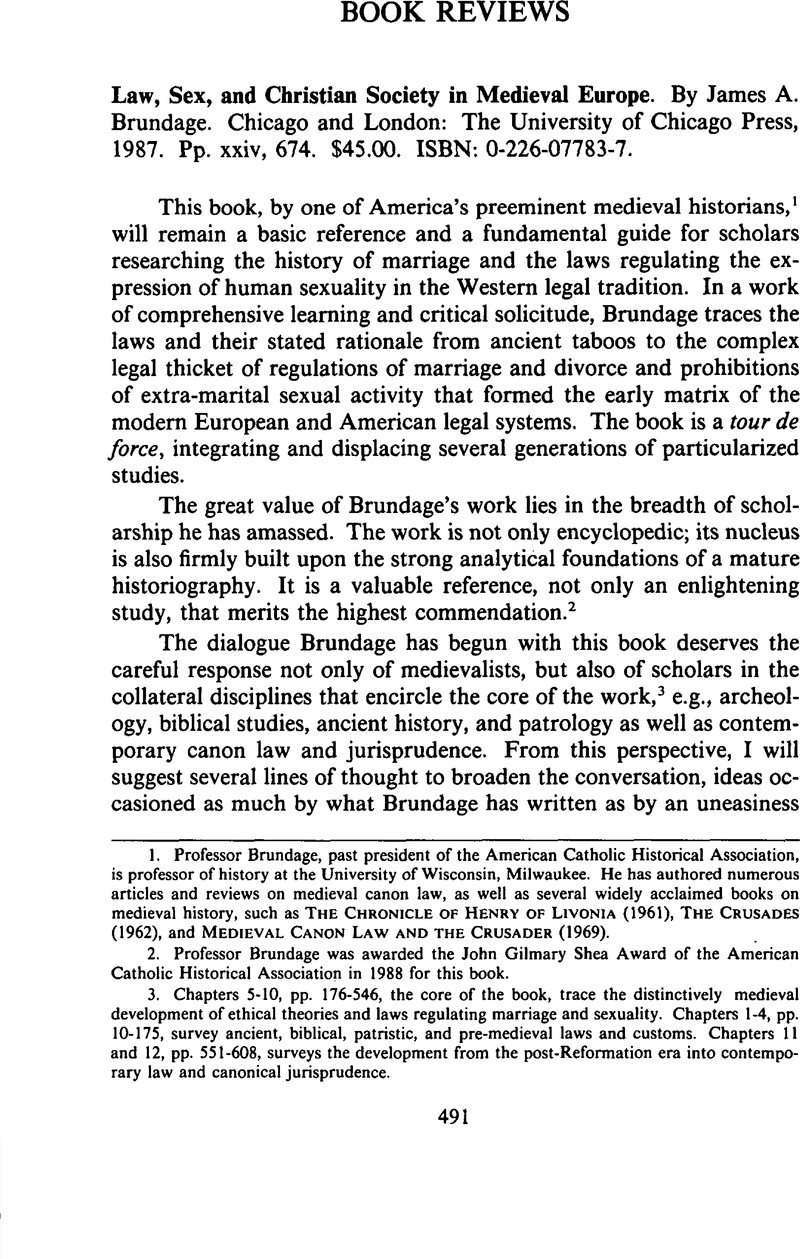No CrossRef data available.
Article contents
Law, Sex, and Christian Society in Medieval Europe. By Brundage James A.. Chicago and London: The University of Chicago Press, 1987. Pp. xxiv, 674. $45.00. ISBN: 0-226-07783-7.
Published online by Cambridge University Press: 24 April 2015
Abstract

- Type
- Book Review Essay
- Information
- Copyright
- Copyright © Center for the Study of Law and Religion at Emory University 1988
References
1. Professor Brundage, past president of the American Catholic Historical Association, is professor of history at the University of Wisconsin, Milwaukee. He has authored numerous articles and reviews on medieval canon law, as well as several widely acclaimed books on medieval history, such as The Chronicle of Henry of Livonia (1961), The Crusades (1962), and Medieval Canon Law and the Crusader (1969).
2. Professor Brundage was awarded the John Gilmary Shea Award of the American Catholic Historical Association in 1988 for this book.
3. Chapters 5-10, pp. 176-546, the core of the book, trace the distinctively medieval development of ethical theories and laws regulating marriage and sexuality. Chapters 1-4, pp. 10-175, survey ancient, biblical, patristic, and pre-medieval laws and customs. Chapters 11 and 12, pp. 551-608, surveys the development from the post-Reformation era into contemporary law and canonical jurisprudence.
4. Sánchez, T., De Sancto Matrimonii Sacramento Disputationum Tomis Tres, 3 vols, in 1 (1621)Google Scholar.
5. “This work is the ornament of the Common Law, and the most perfect and absolute work that ever was written in any human science.” Coke, I Institutes, Proem. Compare F.X. Wernz, Ius Decretalium, T. IV, lus Matrimoniale Eccles. Catholicae, pars prima, 17 (1911) or, more recently, Hennessey, , Canon 1097: A Requiem for Error Redundans, 49 The Jurist 146, 158–66, esp. 165 (1989)Google Scholar. Brundage describes Sanchez' work as comparable to a “complicated tax code.” (p. 564)
6. C. 12, q.1, c. 7.
7. Prosdocimi, L., Unità e dualità del popolo cristiano in Stefano di Tournai e in Ugo de S. Vittore: Duo populi e Duae Vitae,” Etude Le Bras, 673–80 (1965)Google Scholar.
8. See, e.g., Bowers v. Hardwick, 475 U.S. 186 (1986) [sodomy] as well as state legislation prohibiting prostitution, rape, exhibitionism, and child abuse, as well as structuring and encouraging monogamous marriage. Reynolds v. U.S., 98 U.S. 145 (1879).
9. See Ingram, M., Church Courts, Sex and Marriage in England, 1575–1640 (1987)Google Scholar for a continuation in England of Brundage's medieval study.
10. This is not to say that the judgment could not have been supported by other evidence. Jesuit moral theologians since 1612, for example, have held it to be uncontrovertible that, except for the potentially reproductive marital act, every thought, word, quiver, or activity of a sexual nature is intrinsically evil, sine parvitate materiae, and, in intentional, per se a mortal sin. Zalba, M., 2 Theologia Moralis, 136, fn. 43 (1958)Google Scholar. This, of course, is so absurd as to be pathological. There is abundant evidence that after the seventeenth century, while theologians conceded the goodness of sexuality in marriage, they rationalized all other forms of sexual expression into categories of dreadful inhumanity. The communis opinio doctorum that in matters of sexuality there is no parvity of matter is so violently repressive that it nails just about everyone from puberty to grave without guilt. The doctrine itself was not challenged until the Second Vatican Council. Brundage would have improved the book by addition of this evidence into his slim Chapter 11 on the Counterreformation.
11. (New York, 1965).
12. How does the contemporary canon lawyer from Strasbourg, René Metz, rank as a biblical authority for citation here? Or, for that matter, Eric Fuchs? See p. 59, fn. 50.
13. See Grant, , The Apostolic Fathers' First Thousand Years, 31 Church History 421–29 (1962)CrossRefGoogle Scholar; reprinted in 57 Church History, Centennial Supp. 20–28 (1988)CrossRefGoogle Scholar.
14. Frazee, , The Origins of Clerical Celibacy in the Western Church, 41 Church History 149 (1972)CrossRefGoogle Scholar; reprinted in 57 Church History, Centennial Supp. 108 (1988)CrossRefGoogle Scholar.
15. Noonan, J.T. Jr., Novel 22, in The Bond of Marriage 41–90 (Bassett, W. ed. 1968)Google Scholar, cited by Brundage, pp. 87-88, 94-98, 114-17.
16. See Crouzel, H., L'Église Primitive Face au Divorce (1970)Google Scholar.
17. Denzinger-Schoenmetzer, Enchiridion Symbolorum, n. 2725.
18. Theologia Moralis, Lib. VI, Tract VI, De matrimonio (1779). Note that in commenting upon the Summa Theologica, II-II, q. 153, 2 a., Alphonsus remarks that for the Angelic Doctor sex was, indeed, good and would have been all the better in the state of original innocence “given the greater purity of man's nature and sensibility of his body.”
19. Pius, XII, Allocution to Italian Midwives, 43 A.A.S. 851 (1951)Google Scholar [translation mine].


